»
download PDF of this essay

There is a constant tension built into the character of the world’s great cities. Places like Hong Kong, New York, and Mumbai are at once spaces of innovation and places for living – they attract ambitious and adventurous people with the promise of novelty and opportunity, but those people must then coexist with hundreds of thousands of others. This creates a tension between the transgressive processes inherent to a city, and the homogenizing forces of mass cohabitation. There is a constant battle on the edges of privacy, between broad forces of change and individual desires for stable identity. Sound is an ideal case study for understanding this tension. Sound has a physical tendency to find the cracks in all of our barriers. Sound that finds its way to where it is not wanted is ‘noise,’ regardless of the character of the sound itself – a jackhammer or a symphony are both noise when they are disruptive. But music, as purposive sound, has the particular capacity to project ideas and subjectivities: when a piece of music forces its way past the barriers of privacy, it is ‘noise’ – and it has the capacity to be not just disruptive, but transgressive and, ultimately, transformative.
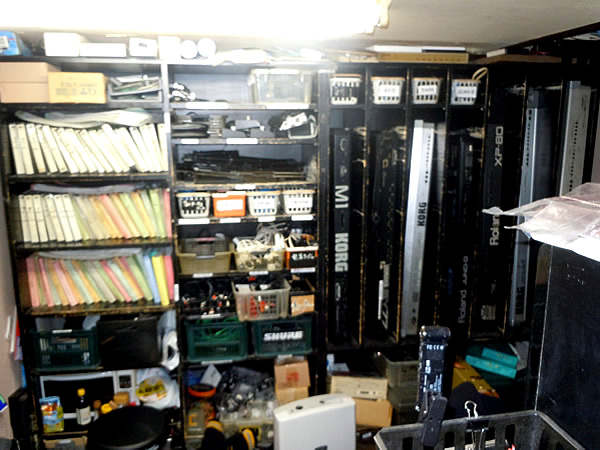
Tokyo has a persistent worldwide reputation as a cramped city, so densely populated that life becomes a constant struggle. The Shibuya Scramble, a five-way intersection crossed by five hundred people every thirty seconds, has become an icon of Tokyo’s density – featured, for instance, in Sophia Coppola’s
Lost in Translation as an emblem of the city as a lonely crowd, moving at the hectic pace of omnipresent commercialization. It’s common to hear Westerners refer to Japanese apartments as “rabbit hutches,” and many of these ideas are simply echoes of Japanese peoples’ own understanding of their island nation as a ‘semai’ – narrow, cramped – ‘shimaguni’ – island nation.
In fact the density of Tokyo is somewhat overplayed. The density of the 23 “special wards” that make up Tokyo proper is indeed remarkable, though still outpaced by that of many developing cities that include significant slum districts. But “Tokyo proper” is a remarkably constrained circle, and once calculations are expanded to include the exurbs where many of Tokyo’s workers live, the equation changes dramatically: in 2007, the Tokyo/Yokohama metropolitan area was only
50th in the world for density.

The density of Tokyo rests on the interaction of physical and ideological realities. It is hard to overemphasize the degree to which Tokyo – in contrast not just to cities in other countries, but to other Japanese cities – is organized around private rather than public spaces. The bulk of Tokyo’s public parks are, in a word, embarrassing – underfunded and underdeveloped patches of lifeless gravel, accessorized with dangerous, rusting jungle gyms (The exception that proves the rule is Shibuya’s Yoyogi park, a large, multi-use space that on weekends attracts thousands of people from across the 23 wards and beyond, reflecting a hunger for unrestricted public space that is not being met more broadly). Private living spaces, moreover, are expected to be entirely inviolate, even from sound, despite the flimsy construction of most housing stock. The open, flowing spaciality of traditional Japanese housing, with its wide spaces and rice-paper dividers leading into gardens, is barely a memory here. It is extremely rare for Tokyoites to host social gatherings in their homes, not just for lack of space, but because of the intense hostility that even minor amounts of noise can trigger in neighbors – thus Tokyo’s famous bar culture. There is a general social taboo against noise (and for that matter many other actions) that might disturb others, extending for example to loud conversations on trains during the day (After about ten pm, the dynamic shifts considerably).
[Performances in outdoor public spaces are not rare, but they're rarely adventurous. Here, rapper Show-K performs a simple, patriotic song with the chorus "Nihonjin Stand Up!" outside of Shibuya Station. Research specifically focused on Japan's right-wing hip hop is forthcoming from the author. Runtime: 01:03]
There are exceptions to the prohibition on public noise mostly for commercial or political activities. In residential areas, exceptions include the loud announcement loops of trucks collecting resalable consumer goods and the anti-Chinese and anti-Korean speeches and slogans of the notorious fascist ‘black vans’. In commercial districts, seemingly any sound that is commerce-related is given carte blanche: the incessant shouting of touts for everything from pharmacies to prostitutes, the banal soundtracks of commercials playing on ten-meter screens, the insane clatter of gambling parlors.
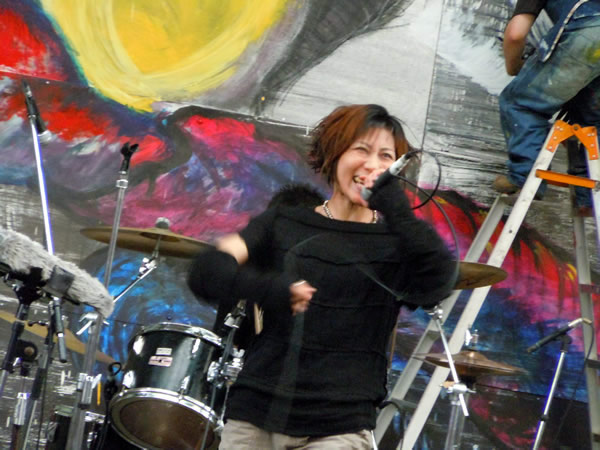
Tokyo’s musicians are granted no such dispensations, and they bear significant burdens from the city’s sound regime. As in many overdeveloped cities, there is little or no space well suited for bands to practice. This, combined with a highly developed musical culture (as of the early 2000s, Japan was the second largest market for recorded music in the world), has given rise to a truly phenomenal number of practice studios, spread throughout nearly every corner of the city. The studios rent soundproof rooms by the hour, providing equipment such as amps and microphones as part of their service, and offering additional equipment, from bass guitars to effects pedals, for a fee. Most musicians bring their own instruments, though, and it’s impossible to make it through a day in Tokyo without seeing aspiring rock and rollers carrying their guitars on the subway or wheeling a keyboard through the street.
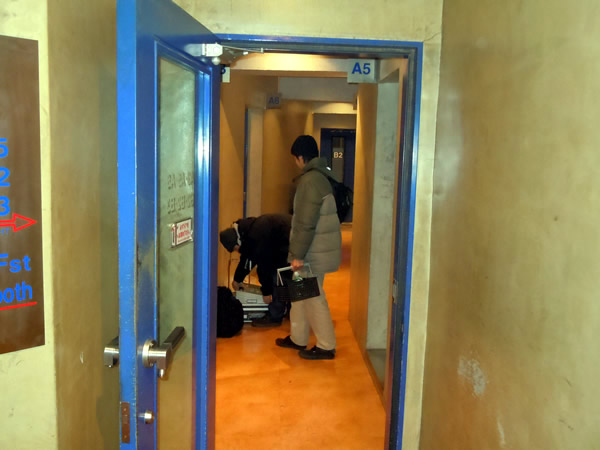
The situation is not particularly conducive to creativity. Studio time is expensive – up to $25US/hr at peak times – placing strict limits on practice. For a few months I sat in on the weekly practice sessions of the hip hop group JETS, and couldn’t help observe that they spent more time traveling and setting up than actually practicing. Compared to, for example, groups that are able to live near one another and collaborate freely in members’ residences (in much of America, often a garage or basement), Tokyo’s musicians are severely hampered.

The one exception to this general practice is the use of parks and open spaces near subway stations and other high-traffic, low-residency areas as rehearsal spaces, mainly by acoustic musicians. One example is the bicycle parking lot near the Japan Rail station at the center of the near-west Tokyo neighborhood of Nakano, which after dark almost always hosts one or two jazz saxophonists, facing a wall as they play from sheet music perched on foldable music stands. Similarly, covered shopping arcades (
shoutengai) often transform after shops close at night into a kind of free space incorporating fortunetellers, peddlers, and musicians either busking or performing. Another frequent feature of these after-dark free spaces are dance troupes, usually practicing elaborate and tightly choreographed routines to hip hop and pop music, and using the dark glass of closed retail spaces to assess their own performance.
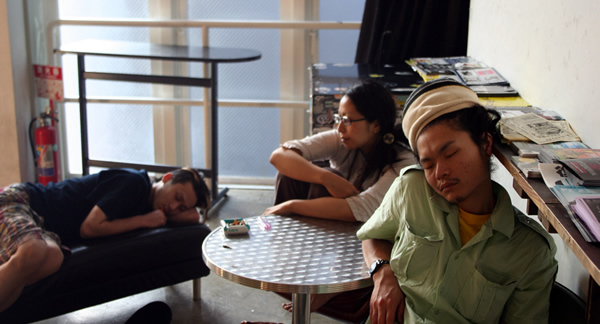
When it comes time for a musical act to perform in a more formal setting, the insularity of Tokyo’s music world takes on a different cast. Particularly in the case of novice or fringe musicians, shows are often in very small venues, tucked away in basements in obscure neighborhoods. Nightclubs frequently operate on an ‘all-night’ schedule, with shows starting at around midnight and running until 4am. This is mainly because Tokyo’s trains stop running between those hours. Crowds of young people, often having snuck in only a few hours of sleep after work, descend on these tiny clubs, and are then very much stuck there for four or five hours straight – not just stuck in the neighborhood by the lack of trains, but fairly often stuck inside the small club because of “no in and out” policies.

The club, then, is shut off from the world around it by the silence of night, and by the same soundproofing technology that swaddles the practice spaces – but with the added sense that the club is an entire alternate world focused on play and creation. Very often, independent entrepreneurs, running small or even off-license cafes, bring and sell food to fuel the partiers. Particularly in hip hop but also in other genres, musical performances are accompanied by ‘live painting,’ in which over the course of the night visual artists produce an original work from scratch. In slightly larger venues there are often multiple stages, or a stage and a dance floor, so that audience members circulate through a small musical complex rather than any singular space, giving texture, geography, and differentiation to their microworld.
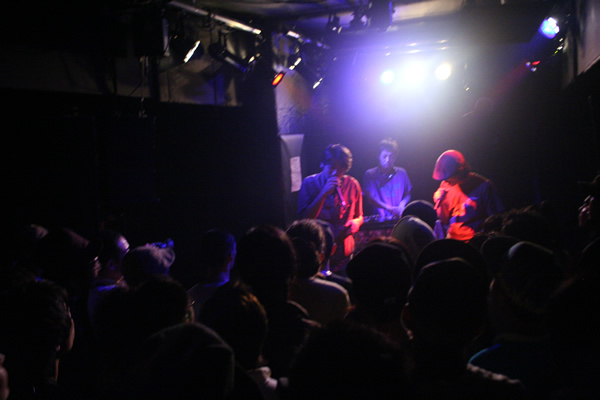
The isolation of marginal, noncommercial music in these spaces has actually strengthened the communities surrounding them, and distilled their worldview, ideology, and the sounds that convey them. As in other musical or artistic settings, subcultures emerge from locations and events, forming social bonds and sharing viewpoints. Musicians observe each other developing and are influenced by one another’s sounds, while audience members over time align themselves around particular artists. A crucial example is the club Heavy Sick Zero in Nakano, where members of a network of avant-garde rappers and hip-hop producers frequently played together starting in the mid-2000s. Heavy Sick is only a few blocks from the Koenji neighborhood where the radical poor-people’s activist network Shirouto no Ran, or “Amateur Revolt,” is based, and it became a site where connections were forged between the two groups. In the space of the nightclub, a loose-knit but coherent musical-political community took shape.
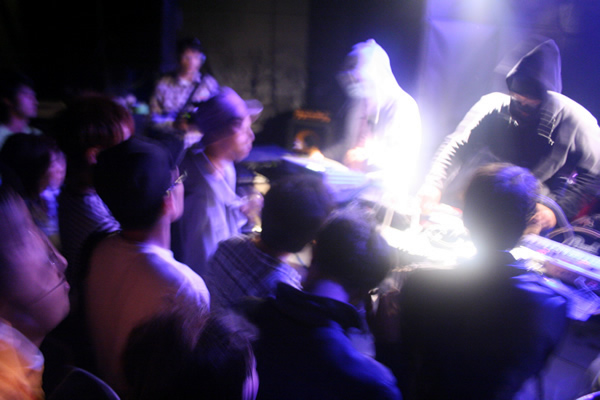
In the period just around 2010, Heavy Sick Zero is where Shirouto no Ran organizer Matsumoto Hajime delivered a rousing speech to an enthusiastic hip-hop audience, and where a raucous anarchist marching band played before a smoky reggae-lounge singer. It was among the main venues for leftist acts like Deep Throat X, whose bone-crushing instrumentals paid tribute both to hardcore pornography and to Okuzaki Kenzo, the radical who shot steel pellets at Emperor Hirohito with a slingshot. The club’s shadowy, marginal, literally underground physical space inevitably inflected the musical and political subjectivities it incubated. Its sounds were distorted, disjointed, and aggressive, and its politics were radical and disruptive. Because of the strict conditions of marginality imposed on it – the sound barriers and time constraints that separated it from mainstream Tokyo society – Heavy Sick represented a zone of considerable freedom, and those who found the space made the most of that freedom. Somewhat ironically, Tokyo’s aversion to noise and disturbance created the conditions for the refinement of disturbance into an art form.
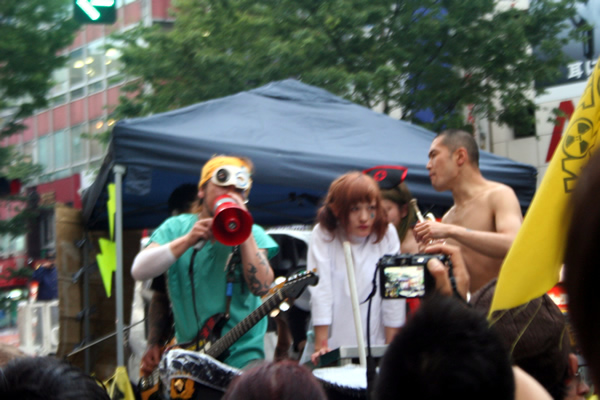
Eventually – perhaps inevitably? – it came time for these sounds and ideas to emerge into public hearing, in dramatic fashion. In the wake of the 2011 Touhoku earthquake, many elements of Japanese politics and society that had long been repressed or ignored were shaken to the surface. Perhaps above all, the meltdown of the Fukushima nuclear plant turned Japan’s reliance on nuclear power into a contentious public issue - and Shirouto no Ran were the only organization in Tokyo truly prepared to provide an outlet for the rising tide of outrage. They had been organizing street demonstrations for years, one of relatively few non-fascist groups to do so regularly. These actions, mostly confined to the down-and-out neighborhood of Koenji, near Nakano, were often “sound demos,” taking advantage of the relative freedom of noisiness granted to permitted political actions to incorporate the abrasive, marginal dance, reggae, punk, and noise music that characterized the neighborhood. When the nuclear accidents unfolded, Shirouto no Ran were well-prepared to go through the permitting process, and wound up spearheading demonstrations far larger than any they had organized before – and as always, these were organized as sound demos.

For one of the marches, held in Shibuya, three different sound trucks – in essence, mobile stages with powerful public address systems – led three columns of several hundred demonstrators each. In the narrow streets of Shibuya, the noise of each was dominating, and stretched far beyond the immediate vicinity of each truck. For four hours, the sound demos were an inescapable, moving presence in one of Tokyo’s densest nodes. The acts featured on the trucks were from widely different genres, including punk, hip hop, reggae, rock, and electronica – but many were affiliated with the Koenji-Nakano underground club nexus, and thus with the confrontational, weird fringes of their respective genres.
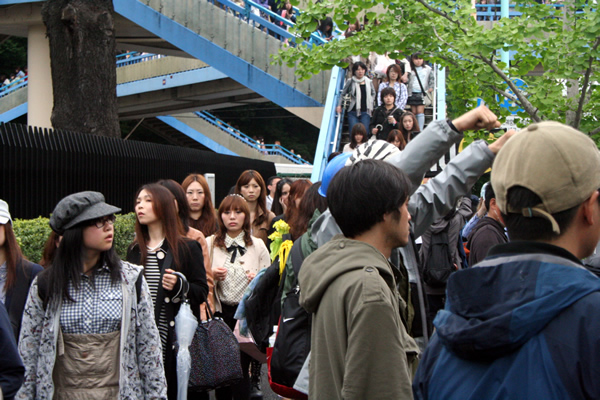
Passersby were publicly confronted with the unpolished, raw sounds of disaffection and disenfranchisement that had been nurtured in the secluded practice halls and underground venues of Tokyo. Out of the margins, their sounds were suddenly in the center: of space, of consciousness. This was the return of the repressed in urban culture – the powerful and sudden re-emergence of social forces willfully marginalized for so long. Bystanders reflected a range of responses, from confusion to disdain to, occasionally, delight. But this was not business as usual – these were the largest demonstrations in Japan since the circa 1960s movement against the ANPO defense treaties with America, and they were accompanied by raucous sound that transgressed conventional boundaries. Sounds from the margin, sounds from the basement, sounds from a secret world - they were the organizing principle of social upheaval, the vanguard of a dissent whose moment had suddenly arrived.
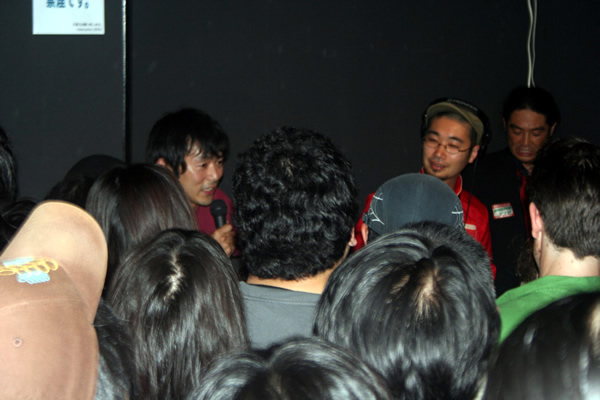
The aggressive sounds of Nakano and Koenji’s hermetic concert caves were ultimately a small part of what became a mass anti-nuclear movement which gained traction all over Japan and manifested in numerous forms. But the sound demos were the first major surge of the anti-nuclear movement, and must be read as transformative in themselves, given the movement’s ultimate accomplishments. Some six months after the Fukushima disaster, Prime Minister Kan Naoto bucked the powerful nuclear lobby to suggest that Japan should move toward a nuclear-free future. Few could have predicted the amazing speed with which this tentative suggestion became a reality - despite backpedaling by successor Noda Yoshihiko, on May 6, 2012, the shutdown of the Tomari plant in Hokkaido left Japan with no operating nuclear generators. The reactors are subject to reactivation after a variety of forms of public review, but most analysts characterize approval of reactivation as an uphill battle. From the margins of Tokyo, from the places where they were intended to be unheard, Tokyo’s musicians helped build a sound and consciousness that prodded this transformation to life.
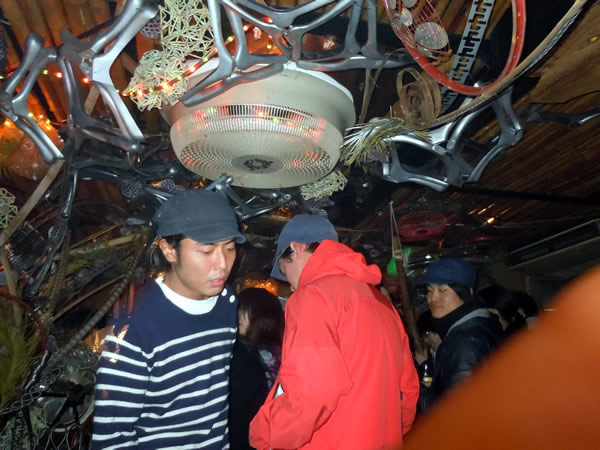
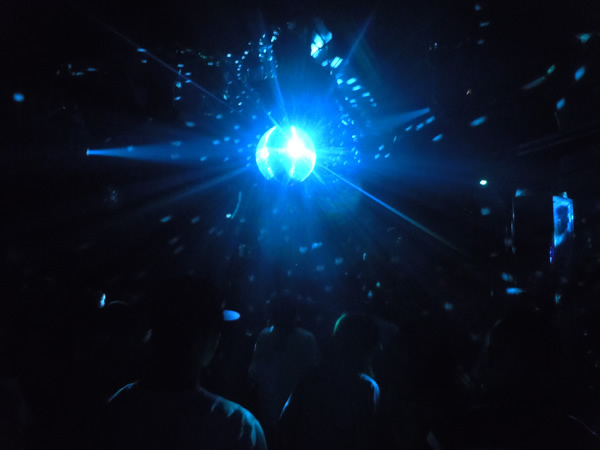
David Z. Morris (PhD, University of Iowa) is a researcher specializing in cultural globalization, media technology, and social change. His work has appeared in
Critical Studies in Media Communication and
The Journal of Popular Music Studies. He is a past recipient of the Presidential Fellowship from the University of Iowa, a Special Foreign Researcher’s Fellowship from the Japan Society for the Promotion of Science, the Samuel Becker Award for Excellence in Research from the University of Iowa Department of Communication Studies, and the Joanna Ploeger Award for new research from the Association for the Rhetoric of Science & Technology. He is currently a Provost’s Postdoctoral Fellow in the University of South Florida’s Initiative on Global Change.





